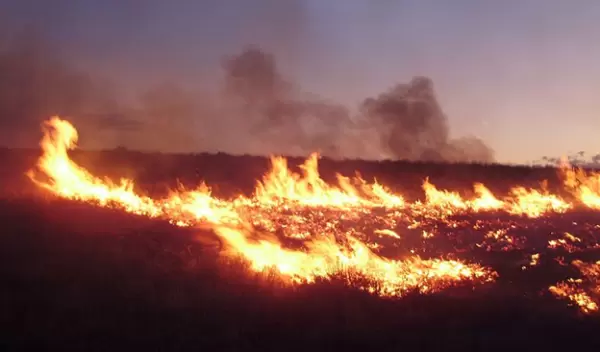
Discovery pushes back the earliest record of wildfire by 10 million years
While wildfires in recent years have raged across much of the Western United States and pose significant hazards to wildlife and human populations, fires have been a long-standing part of Earth's systems without the influence of humans for hundreds of millions of years.
In a new study, Ian Glasspool and co-author Robert Gastaldo, both of Colby College, document 430 million-year-old charcoal produced by wildfires found in samples from Wales and Poland. Their discovery pushes back the earliest record of wildfire by an additional 10 million years.
"Wildfire has been an integral component in earth-system processes for a long time and its role in those processes has almost certainly been underemphasized," said Glasspool, lead author of the U.S. National Science Foundation-supported study published in the Geological Society of America journal Geology. The paper describes the earliest record of wildfire to date.
Glasspool said that wildfires have three essential ingredients: a source of fuel, a source of ignition, such as lightning strikes, and sufficient atmospheric oxygen.
"It looks now as though our evidence of fire coincides closely with our evidence of the earliest land plant macrofossils," said Glasspool. "As soon as there's fuel, at least in the form of plants, there is wildfire pretty much instantly."
The plants that existed 430 million years ago would have looked starkly different from the plants we are familiar with today. Instead of grasses, trees and flowers, flat-lying plants barely an inch tall would have covered much of the landscape, with the occasional waist-high or knee-high plant.
In contrast to much of the diminutive plant cover, however, the ancient fungus Prototaxites would have stood nearly 30 feet tall, towering over the landscape. These plants would have been dependent on water for their reproduction and likely would not have been found in seasonally dry areas.
"The landscape had to have enough vegetation to have wildfires propagated, and to leave a record of that wildfire," said Gastaldo. "There was enough biomass to provide us with a record of wildfire that we can identify and use to pinpoint the vegetation and the process in time."
Today, oxygen makes up approximately 21% of the gases in the planet's atmosphere. Atmospheric oxygen levels have changed greatly over Earth's history, with essentially zero oxygen in Earth's atmosphere for the first part of the planet's history.
As the research study describes, modern burn experiments indicate that wildfires are unlikely to occur below levels of 16% atmospheric oxygen. "If you drop below that level you might initiate a fire but it's not going to propagate," said Glasspool.
Based on the charcoal analyzed in the study, the scientists concluded that atmospheric oxygen once attained levels equivalent to, or possibly above, those of the present. It would have been raised to near-present levels by increased photosynthesis from terrestrial plant life affecting the oxygen cycle. Wildfires would likely have been a significant global phenomenon.


